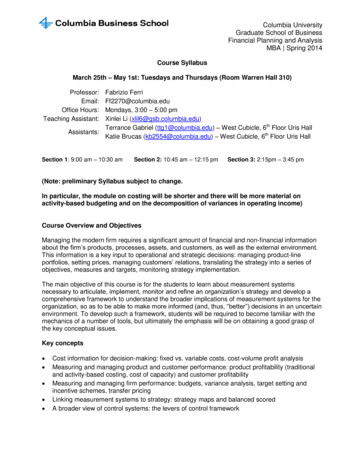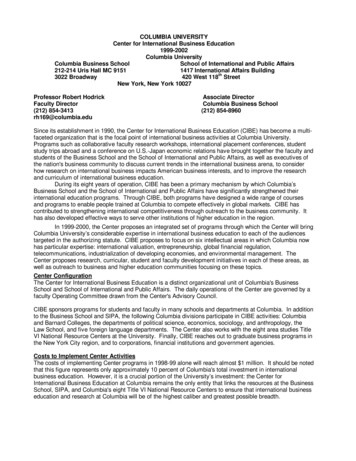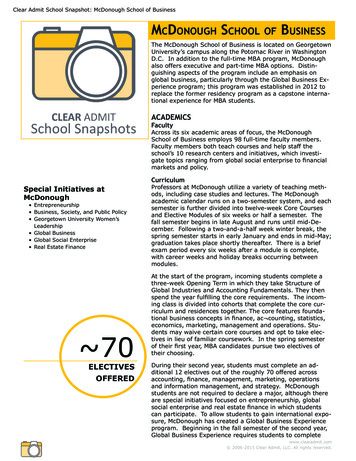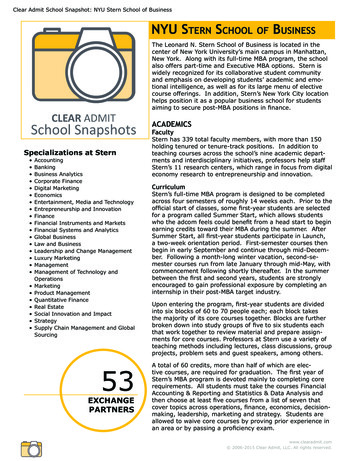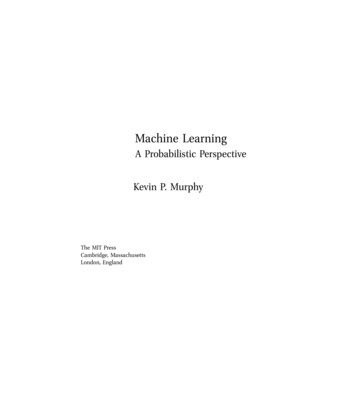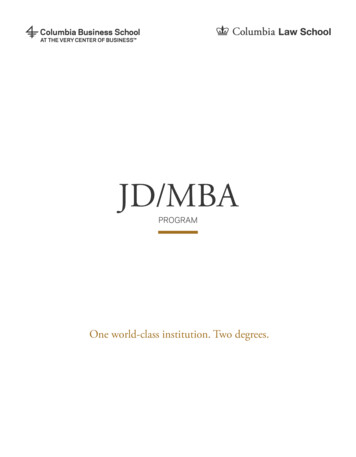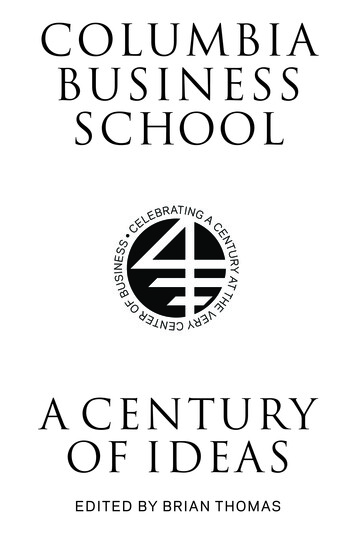
Transcription
COLUMBIABUSINESSSCHOOLA CENTURYOF IDEASE DITED BY BRI AN T H OM AS
COLUMBIA BUSINESS SCHOOL
Columbia University PressPublishers Since 1893New York Chichester, West Sussexcup.columbia.eduCopyright 2016 Columbia Business SchoolAll rights reservedLibrary of Congress Cataloging-in-Publication DataNames: Thomas, Brian, editor. Columbia University.Graduate School of Business.Title: Columbia Business School : a century of ideas / edited by Brian Thomas.Description: New York City : Columbia University Press, 2016. Includes bibliographical references and index.Identifiers: LCCN 2016014665 ISBN 9780231174022 (cloth : alk. paper) ISBN 9780231540841 (ebook)Subjects: LCSH: Columbia University. Graduate School of Business—History.Classification: LCC HF1134.C759 C65 2016 DDC 658.0071/17471—dc23LC record available at https://lccn.loc.gov/2016014665Columbia University Press books are printed on permanentand durable acid-free paper.Printed in the United States of Americac 10 9 8 7 6 5 4 3 2 1
contentsForewordvii1Finance and Economics2Value Investing293Management554Marketing815Decision, Risk, and Operations1076Accounting1437Entrepreneurship1751
viCONTENTS8International Business1979Social Enterprise224Current Full-Time Faculty atColumbia Business School243Index247
f orewordIdeas with ImpactGlenn Hubbard, Dean and Russell L. CarsonProfessor of Finance and EconomicsColumbia Business School’s first Centennial offers a chance for reflectionabout past success, current challenges, and future opportunities. Ourhundred years in business education have been in a time of enormousgrowth in interest in university-based business education. Sixty-one studentsenrolled in 1916. Today that number stands at over two thousand. It is alsoa time of flux in the direction of the education. As was typical at that time,Columbia Business School began as a school emphasizing strictly vocational business. It was only after two books—Higher Education for Business,written by economists Robert Aaron Gordon and James Edwin Howell(commissioned by the Ford Foundation), and The Education of AmericanBusinessmen: A Study of University-College Programmes in Business Administration by the Carnegie Foundation—were published in 1959 that schoolsshifted focus toward greater theory and research. Both reports were critical of current programming at business schools, and they encouragedhigher education institutions to advance a discipline’s knowledge. Today,Columbia Business School continues to build on those early programmingshifts, but it goes beyond, making decisions aimed at connecting facultywith industry practitioners across disciplines in an effort to link Columbiaresearch with practice.
viiiFOREWORDThis book devotes a chapter to each of Columbia Business School’sdivisions, arranged roughly in order of size, starting with the Finance andEconomics division. It also includes chapters that align with four of theSchool’s many centers (value investing, entrepreneurship, internationalbusiness, and social enterprise). Selecting these four was no easy task, asall our centers do significant work and make a valuable contribution tothe intellectual life at Columbia Business School. What set them apart—in three out of four cases—was their holistic influence on what and howwe teach and the very way we understand business today. They are crossdisciplinary and span the boundaries of academic division, business function, or industry. The outlier, of course, is our chapter on value investing;with the investing approach’s intellectual origins here at Columbia BusinessSchool, no commemorative volume would be complete without it.Finance and EconomicsChapter 1 is the book’s longest—an omnibus of the intellectual achievements in finance and economics, from real estate to corporate finance toasset pricing, and everything in between. The bulk of Columbia BusinessSchool’s graduates over the years have gone into either finance or consulting at some point in their careers, and finance and economics have been atthe center of their education.Value InvestingChapter 2 is dedicated to a single scholarly pursuit that had its origin atColumbia Business School: value investing. This chapter traces the originsof value investing from before the publication of Benjamin Graham andDavid Dodd’s seminal text Security Analysis, through its practical application by masters such as Warren Buffett, to the present day. Even now,the theories first posited by Graham and Dodd continue to influence howinvesting is thought about and taught at Columbia Business School and allover the world.ManagementManagement is the subject of chapter 3. Of all the divisions at Columbia Business School, management has perhaps undergone the greatest
F O R E W O R D ixevolution. It is one of the oldest areas of teaching at the School, and it hasalso been the most influenced by new teaching methods and new academicpriorities, including path-breaking work on social intelligence and insightsinto management fads.MarketingChapter 4 focuses on scholarly achievements in marketing, a field whichnecessarily brings together concepts from disparate academic traditionsincluding psychology, sociology, and communications, to name a few.A deep understanding of consumer decision making and the leadingbuyer-behavior model was developed by the Marketing division. In recentyears, the Marketing division in particular has experienced rapid changeas new technologies revolutionize the real-world practice of marketingand advertising.Decision, Risk, and OperationsChapter 5 looks at the School’s achievements in operations managementand the development of mathematical models for decision making. Theresearch triumphs of this division have been particularly important tothe development of modern emergency services in metropolises such asNew York City.AccountingAs noted in chapter 6, accounting has been at the core of Columbia Business School since its foundation. Despite their occasionally esoteric nature,the innovations in accounting developed at Columbia have radically alteredthe way value is measured and businesses are understood.In addition to its core divisions, Columbia Business School has awealth of special centers and programs that produce exceptional researchand provide students with cross-disciplinary opportunities. These centershave grown in response to new challenges in business and are a fundamental part of Columbia Business School, assisting scholars, students, andpractitioners alike in engaging with difficult research questions and challenging real-world scenarios.
xFOREWORDEntrepreneurshipChapter 7 traces the evolution and tradition of entrepreneurship at Columbia.From the School’s earliest days, alumni used the skills learned in the classroom to found organizations and companies that have changed the face ofbusiness. The focused study of entrepreneurship as an academic subject atColumbia has grown exponentially in recent decades. Steady growth in student interest has coincided with a concerted effort by Columbia’s scholars,alumni, and administrators to change the way entrepreneurship is thoughtabout in academia and in the business world.International BusinessChapter 8 notes that international business has grown in prominence as anarea of study. Globalization has radically shifted the attention of businessleaders overseas. Techniques that may have been effective even thirty yearsago in an insular domestic economy no longer suffice. Columbia BusinessSchool’s scholars have risen to the challenge of shifting paradigms to fitglobal demands.Social EnterpriseChapter 9 explores social enterprise as both an academic and culturalphenomenon. Today’s students want to dedicate their careers to achieving specific societal goals in addition to generating new wealth. This dualaspiration goes back to the first years of Columbia Business School, thoughit has taken on even greater prominence over the last few decades withcourses dedicated to the teaching of civic-mindedness and public influence. The Tamer Center for Social Enterprise was born from the realizationthat management and strategy are just as important in government and thenonprofit sector as in private industry.With a strategy grounded in what it takes to succeed in the future,building on the distinctive assets of Columbia’s past and present, I knowone thing: Anything written for the sesquicentennial and the bicentennialwill talk about Columbia’s leading role in developing ideas that drive andshape business, nurturing future business leaders and entrepreneurs in itsstudents, and engaging its amazing network of alumni in ideas and talent.
COLUMBIA BUSINESS SCHOOL
1Finance and EconomicsAndrew Ang, Ann P. Bartel, Patrick Bolton, Wouter Dessein,Frank Edwards, Larry Glosten, Geoffrey Heal, Gur Huberman,Charles Jones, Chris Mayer, Frederic Mishkin, Eli Noam, Andrea Prat,Jonah Rockoff, Lynne Sagalyn, Stephen P. Zeldes, and Brian ThomasIntroductionColumbia Business School’s position in the heart of New York City places itat the most important nexus of the global financial industry. It’s no coincidence that finance and economics are at the very core of Columbia BusinessSchool’s research and scholarship.Finance and Economics is the School’s largest division, in terms ofboth faculty and courses taught. Its scholarship runs wide and deep, takingin everything from stock market fundamentals to corporate finance, realestate, and micro- and macroeconomics. The 2007–08 financial crisis andsubsequent recession underlined the real-world application and importance of rigorous research in these areas.With advances in high-frequency trading and a growing interest inbehavioral finance, the division’s research is rapidly evolving, as has beenthe case since the School’s foundation. The biggest reason for the centralityof finance and economics, though, is that these are fundamental to business. This chapter traces the growth, through bull and bear markets, offinance and economics at Columbia Business School.
2FINANCE AND ECONOMICSThe Early YearsAs part of its first curriculum in 1916, Columbia Business School transferreda set of courses in applied economics from Columbia University’s PoliticalScience department. This was both a practical and a symbolic beginning:from its founding, Columbia Business School specialized in translatingsocial science theory to real-world business practice. These first coursesincluded the core subjects of corporate finance, statistics, insurance, andmoney and banking that have remained key to our curriculum ever since.The School maintained strong ties with the University’s Political Science department and then with its new Economics department. TheSchool’s standing in finance and economics grew markedly until 1931, whena number of deaths and retirements left Columbia University’s Economicsdepartment understaffed. To solve the problem, five professors of financeand economics were asked to move from Columbia Business School toColumbia University’s Economics department. These were James C. Bonbright, Robert Murray Haig, Roswell Cheney McCrea, Frederick C. Mills,and J. Brooke Willis. The shift did not prevent McCrea from serving as thedean of Columbia Business School from 1932 to 1941. Many of them eventually returned to Columbia Business School.The School’s finance and economics faculty and program grew steadilyin size and stature, until two key reports in 1959 upset the business schoolworld as a whole. The Carnegie Foundation and Ford Foundation sponsored reviews of the MBA curriculum that agreed in large part with eachother: most MBA training was little more than vocational, taught by professionals rather than scholars. The two reports urged business schools tobecome more academic, that is, more like the university departments thatmany of them came from. These reports mark the start of the modern erafor business schools, when they joined other professional schools, such asthose in law and medicine, as key institutions of modern society.A Historic MergerIn the past, Columbia Business School’s finance and economics programhad three divisions: Money and Financial Markets, Business Economics,and Finance. The economists in the Money and Financial Markets and Business Economics divisions were largely traditional academics who published
FINANCE AND ECONOMICS 3in top-rated journals. Finance, on the other hand, featured the kind of practitioner teacher that the Carnegie and Ford reports lamented. Columbia’sleading light in this regard was Roger Murray, a twenty-year veteran ofWall Street. He would go on to become a frequent adviser to members ofCongress and business leaders.This scholar/practitioner divide led to tensions between Finance andthe other two divisions, over course content, faculty appointments, andindeed the future character and stature of the School.Frank Edwards, though formally the head of the Money and FinancialMarkets division, became an early advocate for a stronger finance group atColumbia Business School. Edwards argued that the hiring problem waspartly structural and could be significantly improved by a reorganization ofthe three divisions. Excellent scholars already existed in all three divisions,but there was no leadership capable of aligning everyone behind a coherentschool strategy.In 1994, building on Edwards’ proposals, Dean Mayer Feldberg mergedthe three divisions into one, making Edwards the head of the new Financeand Economics division. A while after the consolidation, Edwards proposeda triumvirate leadership structure. There would be a chair of the entire division and subchairs for finance and economics. Edwards’ eventual choicesfor these two positions were Larry Glosten for finance and newly hiredStephen Zeldes for economics. All three held these positions for many yearsand worked together to build the newly formed division.Taking OffThe new Finance and Economics division took off quickly. The biggestimprovement came in hiring, as t
sored reviews of the MBA curriculum that agreed in large part with each other: most MBA training was little more than vocational, taught by pro-fessionals rather than scholars. The two reports urged business schools to become more academic, that is, more like the university departments that many of them came from. These reports mark the start of the modern era
